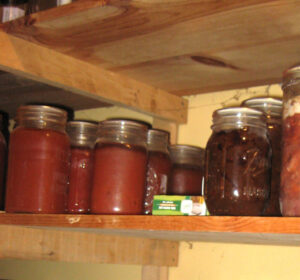- Like
- Digg
- Del
- Tumblr
- VKontakte
- Buffer
- Love This
- Odnoklassniki
- Meneame
- Blogger
- Amazon
- Yahoo Mail
- Gmail
- AOL
- Newsvine
- HackerNews
- Evernote
- MySpace
- Mail.ru
- Viadeo
- Line
- Comments
- Yummly
- SMS
- Viber
- Telegram
- Subscribe
- Skype
- Facebook Messenger
- Kakao
- LiveJournal
- Yammer
- Edgar
- Fintel
- Mix
- Instapaper
- Copy Link
A version of this column first ran in the Roane County (WV) Reporter and Times Record. Support local journalism! Subscribe to your local newspaper. This is one of a series of blogs for new gardeners. Start reading the whole series here: Part 1.
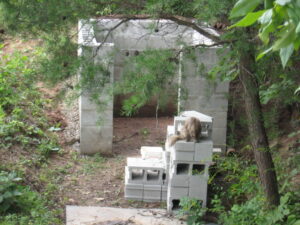
Our root cellar under construction. We built a garden shed on top, back-filled the sides, and hung a heavy wooden door.
It’s too hot and too dry and there are still too many bugs. Nonetheless, I hope you are now harvesting lots of vegetables from your garden. If you have too much at once, how can you preserve it for later when you need it—winter, maybe?
The best approach to food preservation depends on the vegetable. The easiest are those you can just put on a shelf in a dark place at room temperature. In this category are sweet potatoes and winter squashes (both harvested in fall). In my experience, these keep for months and in the case of the sweet potatoes, they will even heal up from a cut, one reason these are so well worth growing (also despite their sweetness, they’re okay for diabetics). Getting the slips started can be difficult, but once they’re established in your garden they’re not a lot of trouble.
Some things do well in cool moist storage, such as a root cellar. If you don’t have a root cellar, you can possibly use an unheated garage, or a corner of your basement. The key is to keep the air as cool as possible without actually freezing, and moist. In this category the stars are apples, pears, cabbages (and turnips and beets and Brussels sprouts), and potatoes. But note that apples and pears naturally emit ethylene gas, which causes other produce to ripen, and rot, faster. Thus ideally you store them separate from potatoes. Also, cabbage and their kin can unpleasantly flavor other vegetables if stored together. Therefore, in the ideal storage room, these will also be separate. This ideal storage room has no maintenance costs, of course, since it exists only in theory. In practice, my potatoes do fine in my root cellar even though it’s much warmer than the ideal 34 degrees, and they may sprout a little faster with apples in the same room but they still keep for months.
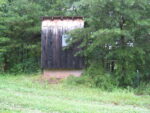
The storage shed on top of our root cellar.
Then there are the things that can be dried. Most fruits can be halved or sliced and dried in an electric dehydrator; so can many vegetables, mushrooms, and herbs. But the machine is noisy and take a lot of electricity. So I only use mine for apples and pears—and now that the evil squirrels have taken to stealing all my orchard fruits months before they’re ripe, I have no need for storage of fruits (what I need, I think, is a shotgun). There are solar dehydrators which take a little longer if the sun is shining, and don’t work at all if it’s not. You can find plans for these and build one yourself.
Freezing is probably the preservation method for the longest list of items. Some are supposed to be 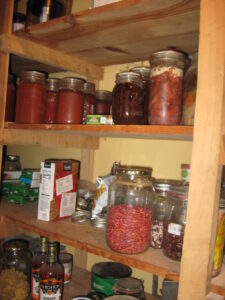 blanched—dropped in boiling water for a minutes or two, then fished out and dropped in ice water—to preserve color and flavor. But I read that you get better preservation of nutrients if you don’t blanch, so I take that as a good excuse to skip it. I do usually spread the items on a cookie sheet and semi-freeze them first, then scoop them into freezer bags—this way they don’t freeze into one solid lump. So if in the winter you want six strawberries, you can pry six out of a container and put the rest back.
blanched—dropped in boiling water for a minutes or two, then fished out and dropped in ice water—to preserve color and flavor. But I read that you get better preservation of nutrients if you don’t blanch, so I take that as a good excuse to skip it. I do usually spread the items on a cookie sheet and semi-freeze them first, then scoop them into freezer bags—this way they don’t freeze into one solid lump. So if in the winter you want six strawberries, you can pry six out of a container and put the rest back.
There isn’t much that can’t be frozen, but I only have the freezer that’s on top of my fridge, so capacity is limited.
Another reason I prefer canning for things that can be either frozen or canned is that once you have invested the energy involved in canning something, you can put it on your shelf and it will keep indefinitely; whereas something that has been properly frozen for months becomes worthless if you have a couple of days of power outage. Mostly, I can tomato sauce because we use a lot and I want it organic—tin cans can leach unwholesome substances into food, especially in the presence of acid, which tomatoes have. So I grow a lot of tomatoes, run them through a strainer to remove seeds and peels, then cook down the liquid to half its volume before canning. Tomatoes can be boiling-water bath canned but I usually use the pressure canner as I seem to get fewer bad seals with it.
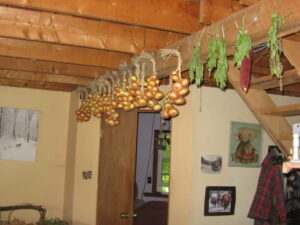
Onions and herbs drying.
Many fruits are acidic enough for canning—most vegetables and meats need a full ninety minutes at high pressure, which hardly seems worth it for something like green beans, to me (for venison, yes). Pickles are highly acidic, and can be done with the boiling water bath approach—this is better to avoid mushiness, too (I think the primary key to avoiding mushiness in pickles is to use super fresh produce, not something you picked yesterday). You need more advice than I can give here for safe canning and pickling directions—you can find advice online, or in library books, or get it from the WVU Extension.
Other things I can are jams, applesauce and cider, maple syrup and sorghum syrup and salsa. I like to make salsa because there are usually weeks in September when I’m no longer getting enough tomatoes to make sauce, but I still have some, and plenty of peppers and onions and garlic. I’ve also found mixed pickles a handy way to use up a few beans, some carrots I’ve cut the wormholes out of, the tiniest onions (peeled and whole), maybe some celery, summer squash—in other words, a little of this and a little of that. Add some peppercorns, mustard seeds, half a bay leaf, some small garlic, and the brine…and your summer bounty is preserved for all year—and next year too.




